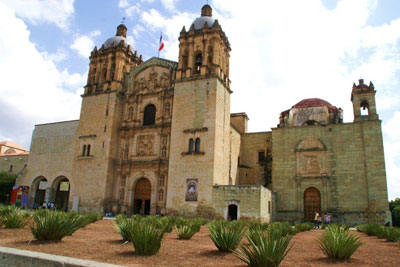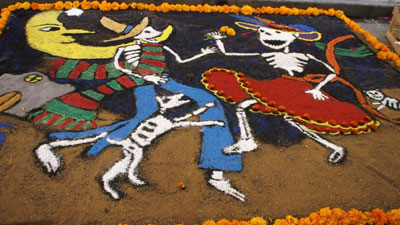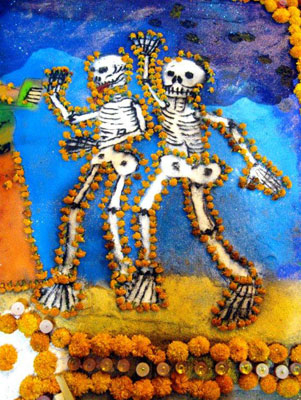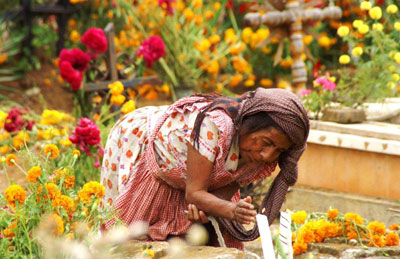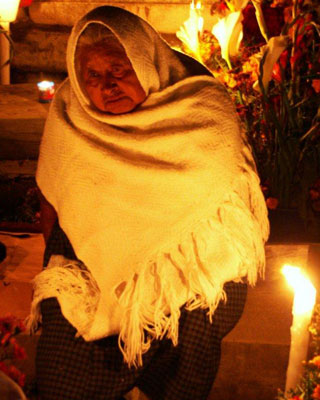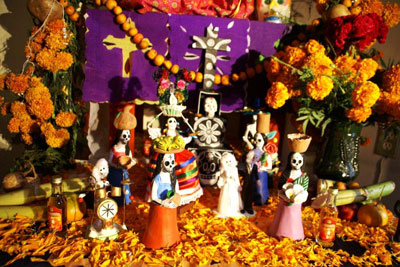Enjoying the party-like atmosphere of Oaxaca’s Day of the Dead festival
Fred DeVinney, Walnut Creek, CA
In Condé Nast’s 2009 Readers’ Choice poll, Oaxaca, Mexico, was listed among the top 10 cities in the Americas (excluding the US). After my late-October ’09 trip there for the marvelously colorful Day of the Dead festivities, I can certainly understand why.
El Diá de los Muertos is celebrated each year in Oaxaca during the week leading up to the first of November. Instead of mourning the dead, Mexicans celebrate their memory, and this is the time for a joyous reunion of family members, living and dead.
Colorfully decorated cemeteries and plazas and people wearing outrageous and often macabre costumes and masks, plus music, parades and revelry, engulf Oaxaca in an atmosphere of Carnival.
Settling in
My wife and I arrived on Oct. 26 and were able to witness the buildup to the celebrations that were to climax on the nights of Oct. 31 and Nov. 1.
Much of life in Oaxaca centers around the town’s main square, the Zócalo. This large, colorful square with a park in the middle is surrounded by restaurants, hotels and shops. We spent a great deal of time in outdoor cafés there, relaxing, people-watching and soaking up the ambience.
Be sure to visit the Palacio de Gobierno statehouse and its excellent murals. And during festival time there are colorful altar displays, sand sculptures and a number of special activities.
The Zócalo is a wonderful place for lunch or a respite from sightseeing or shopping. We ate at Café del Jardín, twice. The very good grande-sized sandwiches (about $8) were ample for two, but the encore of complimentary chili-garlic Spanish peanuts drizzled with fresh lime juice was the decider! Another lunch was enjoyed on the terrace of Hotel Marqués del Valle, also located right on the Zócalo.
Most evenings featured concerts from a variety of musical groups from 6 to 8, which made for a nice break before dinner. Invariably, we would head back to the square after dinner to absorb more of the local color, often walking along the Andador Macedonio Alcalá, a pleasant pedestrian mall of shops, galleries and restaurants.
Discovering Oaxaca
On our second day, truckloads of sand showed up in the Plaza de Alameda de León, located next to the Zócalo and fronted by the landmark Catedral de Oaxaca. Over the next three days, a splendid array of colorfully decorated and painted sand sculptures took form.
Macabre figures, giant skeletons (even one on a motorcycle) and an entire re-creation of the façade of the cathedral plus a wide variety of skulls and animals turned this plaza into a wonderful sight to behold.
As we had ample time to explore at a leisurely pace, we spread the highlights out, taking in one or two major events each day and leaving time to stroll, shop and, yes, hang out on the Zócalo.
The Centro Cultural Santo Domingo, including the beautiful church of Santo Domingo and the Museum of Culture of Oaxaca, is a great place to start your exploration of the city. The church has a spectacular interior. I had to let my eyes get adjusted as I entered to appreciate the soaring Sistine Chapel-like ceiling of the nave.
The museum next door chronicles the history of Oaxaca from ancient times up to the present. With 14 large rooms to cover, it looked daunting. We found the first four rooms, covering the ancient cultures prior to the Spanish conquests, the most interesting and focused the majority of our time there. I would suggest using the audio headset.
The ethnobotanical gardens that are also part of this complex required separate admission.
I would highly recommend the Museo de Rufino Tamayo with its pre-Columbian collection that includes some wonderful works with animal motifs, but you might want to save that for another day.
Several blocks north of the Santo Domingo church and museum is the neighborhood Los Arquitos, where residents have adapted an old aqueduct into homes and shops. The very pleasant Pochote Market takes place there on Friday and Saturday.
I’d also recommend a visit to the vast labyrinth of the colorful Mercado Juárez, a couple blocks southwest of the Zócalo, and then maybe a walk over to the baroque Basílica de Nuestra Señora de la Soledad and its museum.
A number of folkloric dance performances can be seen throughout the city. We opted for a colorful presentation at the Monte Albán hotel, just off the Zócalo. A dinner option was offered, but we chose to attend just the 8:30 p.m. show for about $15 per person.
Area exploration
There are some great sights surrounding Oaxaca, and the Monte Albán archaeological site should be at or near the top of the list. We took a half-day guided bus tour to Monte Albán, a UNESCO World Heritage Site set in the hills above Oaxaca that provides dramatic views of the surrounding mountains and valley.
This city of the present-day ancestors of the Zapotec peoples flourished from 500 BC to AD 750, and today it provides some fascinating ruins to explore.
Our half-day tour cost around $18. There is also a full-day option, which includes visits to a village market and other areas of interest, for $30.
We also enjoyed a half-day tour to Mitla. It was scheduled to last until 2 p.m. but ended close to 4 p.m. due to our wonderfully enthusiastic guide.
While not on the scale of Monte Albán, Mitla, which reached its apex in the 13th century, is worth a visit if you have the time. Our “half-day” tour also included visits to a village market and a rug-weaving exhibit and a stop at El Tule, an awesomely massive cypress tree.
Joining the crowd
Our other excursions out of Oaxaca were provided by the lovely B&B Casa de Mis Recuerdos, where we stayed for the last four days of our trip. They had a full week of activities that we could take advantage of. This ended up providing some of the most meaningful experiences of our trip.
Many in our group loved the all-day cooking class taught by Nora, who runs this small, family-owned hotel along with her husband, William Frederick.
We chose to join two night tours, on Oct. 31 and Nov. 1. On the first night, after a very nice light supper of tamales and hors d’oeuvres in the B&B’s courtyard, we boarded a small bus for a short drive to the festivities taking place at the cemeteries of Xoxocotlán.
The gravesites were festooned with beautiful flowers, candles and dishes of the favorite foods of the deceased. Skulls, skeletons and other macabre figures were prevalent.
We visited two cemeteries linked by a midway of entertainment, games and food stalls. William, Nora and Juan, holding high a huge head on a stick, were our guides for this colorful evening.
A wonderful concert with a large orchestra and splendid vocalists took place right outside the first cemetery. Topped off with a full moon, it was a night to remember.
On Nov. 1 we traveled to three villages in the Etla Valley for a night of wild celebrations. Nora and Juan led us first to a village where the celebrants, in a riot of costumes and masks, were dancing up a storm to a very enthusiastic band. After about an hour of this revelry we headed for another village where there were only a few people following a band through the streets. At first it was a little of a letdown — until we joined in the parade, which got bigger and bigger as we walked along. As opposed to the first frenzied stop, where we were just observers, here we became part of the celebration.
Our last stop was at a small arena with bleachers where, after a short satirical play was performed, the arena filled with dancers in outrageous costumes and masks in a chaotic celebration of music and dance. Those two nights indeed had a feeling of Carnival.
Accommodations
Our loose-knit group of 12 stayed at two different charming, small hotels/B&Bs. We ended up staying four days at each and loved both.
The first four nights were at Hotel Las Golondrinas (phone 951 514 3298, www.hotellasgolondrinas.com), with pleasant rooms situated around lovely gardens. Our room, B6, had a little terrace and was a real bargain at $53 per night. Breakfast in a nice garden setting was extra but offered wonderful fresh fruit, yogurt and granola combinations in addition to the usual fare.
Casa de Mis Recuerdos (toll-free from the US, 877/234-4706, www.misrecuerdos.net) cost $105 for a spacious double room and included an excellent full breakfast that Nora and her staff prepared, served in our choice of the lovely dining room or the courtyard. The rooms were beautifully decorated, and the open lounge/patio area was a nice place to relax, gather and enjoy a margarita.
The full program of activity options made this place special. The program the first night, with supper, cost $60 per person and the night in Etla Valley, $40. Nora’s all-day cooking class cost $60 each and included an elaborate meal.
We sampled a number of restaurants, and our favorite was Los Pacos, where our meal cost around $20 per person, with Chilean wine. We also liked the much-touted Casa Oaxaca, a block from the Camino Real hotel, with its rooftop garden setting overlooking the back of the Iglesia de Santo Domingo ($35 per person, with wine), and we enjoyed an inexpensive dinner ($12-$15 per person) and lunch ($10) at the rustic Zandunga restaurant.


